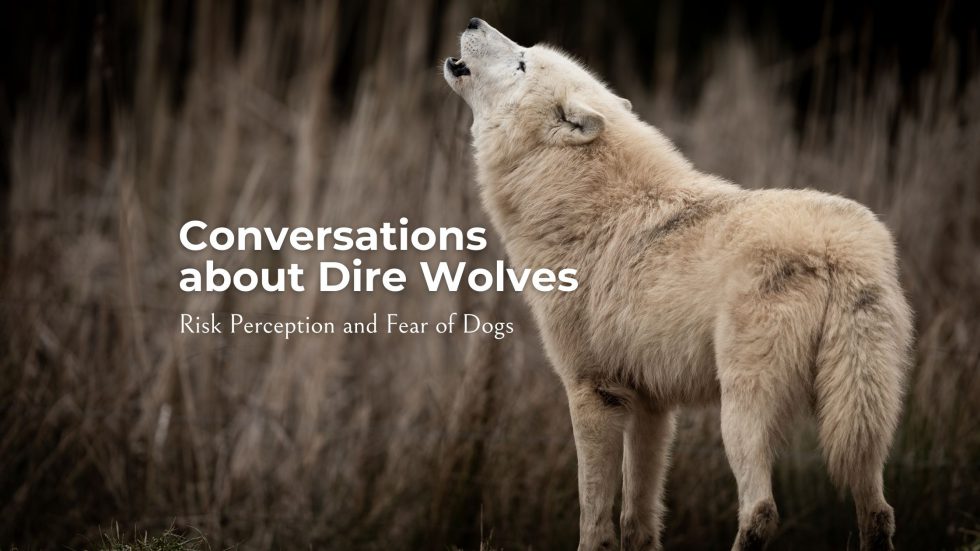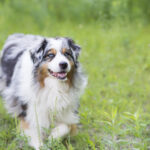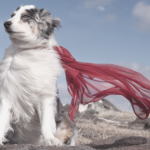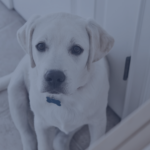The Academy’s director Jean Donaldson speaks with staffer Kristi Benson about human evolution and the real risks, to both humans and dogs, that result from our fear of dogs.
Kristi:
When people think about evolution, my sense is that they conjure up moths on trees in Industrial Revolution England or lungfish with delicate little flipper legs and feet dragging themselves up onto muddy shores. Or, they might think of that iconic image, showing the progression of humans from an earlier ancestral species of small primate on the left, through ever-more-erect hominids, to our own form on the right. It’s a bald fact that humans evolved, just as all life has. But I suspect that people don’t always consider how our own evolutionary history has left a mark on our behaviour, and how this sets us up to behave in certain ways in certain contexts. One of the ways that evolution has armed us to behave is in regards to the assessment of, and response to, perceived threats or risks. What do we know about our ancestral environment and the risks our long-ago ancestors were dealing with?
Jean:
A vital question for understanding how our emotions influence important stuff like resource allocation for public safety! We know from research on our close primate relatives that things such as spiders, snakes and large predators with pointy teeth were common hazards in our past, and that this fear is highly conserved. For instance, modern kids (or adults) who’ve never had a bad experience with snakes are more likely to fear them than they are, for instance, ducks or trees or motor vehicles. And here’s the key thing: for most of us, motor vehicles represent a much, MUCH higher risk of injury and death than do snakes or animals with pointy teeth. So if we “believe” our emotions (think with our “paleo-brains”) we’ll end up making errors, including allocating resources towards the wrong stuff.
So if we “believe” our emotions (think with our “paleo-brains”) we’ll end up making errors, including allocating resources towards the wrong stuff.
Kristi:
Animals with pointy teeth…including dogs? Dogs absolutely have big, wolf-life dentition and the strength to do some pretty serious damage. If we are talking about the things in our environment during our last evolutionary bottleneck that might kill us, snakes and pointy-toothed predators such as wolves and big cats are high on the list—and like you say, this means that humans even today very regularly fear them. But people are often scared of domesticated dogs, too. Which leads to a reasonable question: have dogs ever killed people in large numbers? And if we’re talking about ‘evolutionary bottleneck’ times, is rabies implicated in the canine-caused death toll, or is it not a factor due to timelines or other reasons?
Jean:
Most definitely including dogs I think. They DO have big, wolf-like dentition and many breeds I would wager “read” as wolves to our paleo-brains. And so we disproportionately fear dogs. To my knowledge, there has not been what would ever be termed large numbers of people killed by domestic dogs, although your rabies question is an interesting one! There’s plenty of evidence that we have invertebrate fears that are driven by our co-evolution with parasites but there’s not been much of a look at dogs as evolutionarily perceived vectors (or even bats). So I feel relatively confident saying our exaggerated fear of dogs is likely driven by their resemblance to predators that did represent significant human-eating pressures in our past.
This fear manifests in a couple of ways. One is the stark contrast between the extremely modest numbers of people killed by dogs in a given society and the intensity of “something must be done” outcry when an instance makes the news. And the other is the curious prevalence of what we affectionately call FOD (Fear Of Dogs) among people, including, interestingly, dog professionals, who get disproportionately excited by injuries that, were they gotten via a cheese grater in the kitchen, would warrant an eyeroll and a bandaid.
So bottom line: I’m willing to bet the reason death by dog triggers our availability bias (it’s a vivid way to go) is that waaaaay back, failure to avoid pointy-toothed predators picked you off the evolutionary playing field.
So bottom line: I’m willing to bet the reason death by dog triggers our availability bias (it’s a vivid way to go) is that waaaaay back, failure to avoid pointy-toothed predators picked you off the evolutionary playing field.
Kristi:
Right-oh…for our ancestors, avoiding the fate of being dinner for some Pleistocene predator was a prime directive, and we’ve all inherited behavioural tendencies from those hominids who managed to successfully evade and avoid those predators. If considered solely as an anachronistic trait or fascinating but meaningless part of our modern human repertoire—a sort of behavioural appendix—fear of dogs and the desire to reduce the extremely small risk that dogs pose doesn’t seem important. We all, every one of us, understand the very human need to reduce our risk of death and injury, especially over the last year as a pandemic has swept across the globe and sickened more than one hundred million, and killed more than two million as well. But although it appears to be neutral, your points are good ones: this tendency is not without cost. There are real costs to both people and dogs. People spend time, money, and emotional bandwidth fighting for causes that feel important but a look at the numbers shows they are not (breed discrimination comes to mind). And dogs suffer terribly when their owners, their trainers, and the public fear them: everything from vastly reduced welfare from preventing normal social behaviour to euthanasia for minor aggression or even just exuberance.
The psychologists who study bias tell us, though, that just knowing our brains do this thing doesn’t help us not do it, when it comes to biased thinking. What’s your approach to both helping the trainers in your stable with their own anachronistic fears, and preparing them to fledge into the world where all their compatriot humans will be operating under a “reduce the risk” platform?
Jean:
So, so tough! Just knowing our brains do this thing is really not enough. Our efforts in The Academy – stuff like giving it a (hopefully) catchy label (“FOD”), repeating and repeating that it’s A Thing That We Ought To Consider Pushing Back Against (our Let’s Habituate webinars, deflationary language when there’s a mismatch in trainer or owner verbiage about a bite and the objective level of injury, pointing it out, including it front and center in our regular material on cognitive biases, evolution and aggression cases etc.) – *seem* to catch when a student self-identifies as having FOD and makes a decision to reduce it. In other words, our particular efforts are necessary but not sufficient. Someone has to recognize that they have it. And I think many trainers don’t so self-identify. They think they *don’t* have it. Others have it.
It’s also a tall order because it’s the cultural norm. The entire culture freaks out when dogs threaten or bite, even when there’s miniscule damage. So anybody who has an ah-ha about FOD and makes progress pushing back against it finds themselves in a small minority in the culture at large, including, by the way, in the dog training culture. And yet it’s madness when you think about it. Could you imagine presenting yourself in an emergency room and then lobbying the municipal government to Do Something every time you had a minor kitchen injury?
And so I think your point about helping trainers who do understand and have successfully pushed back against their own irrational FOD, helping them not go into despair once they’re operating in the world where it’s ubiquitous, is an important one. Trainer burnout has many vectors, and one of them is how very about dogs we trainers are and yet must watch them be killed for arguing, and killed by the person whom we identify as our own client. We need to not let this eat us alive.
And yet it’s madness when you think about it. Could you imagine presenting yourself in an emergency room and then lobbying the municipal government to Do Something every time you had a minor kitchen injury?
Kristi:
“We must not let this eat us alive” indeed! An apt metaphor for this discussion. Thank-you Jean, a fascinating topic and a fun conversation.
The Academy for Dog Trainers was founded in 1999 by Jean Donaldson. Jean is one of the top dog trainers in the world and has lectured extensively in the US, Canada, the UK, Europe, Australia, New Zealand and Japan. She is a four-time winner of The Dog Writers’ Association of America’s Maxwell Award, and her seminal book The Culture Clash was named number one training and behavior book by The Association of Pet Dog Trainers. Her other titles are Mine! A Guide to Resource Guarding in Dogs, Fight! A Guide to Dog-Dog Aggression, Dogs Are From Neptune, and Oh Behave! Dogs From Pavlov to Premack to Pinker.
Kristi lives in San Clara, Manitoba, Canada, where she is the owner of Kristi Benson Dog Training. She works with clients both in person in the surrounding communities and via distance consults with dog owners across Canada. Kristi also creates online learning courses with her Academy colleagues. At the Academy, she runs special projects like the Husbandry Project and liaises with the Academy’s research teams. She also organizes the weekly Wednesday webinars offered to students and grads, finding fantastic guest presenters to compliment the webinars produced in-house, such as quizzes, interactive webinars, and curriculum-related content. Kristi also coaches and mentors students.
